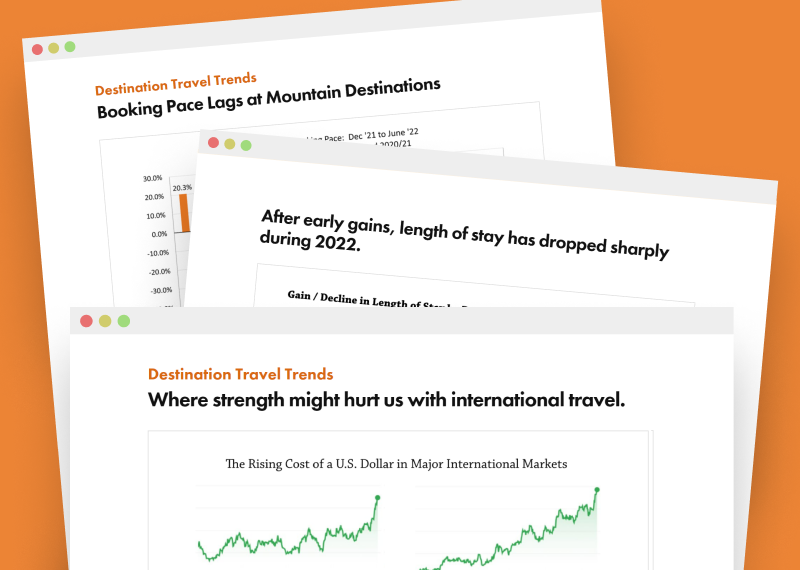 Katie Barnes
Katie Barnes
Nothing like a strong wave of mid-November snowfall from the Sierras to the Rockies to give winter bookings a boost for the upcoming ski and snowboard season at western mountain resorts. According to DestiMetrics* monthly Market Briefing released yesterday by Inntopia, as of Nov. 30, aggregated bookings made during the month of November for arrivals from November through April are up 12.8 percent compared to the same time last year. Healthy snowfall triggered an immediate response as bookings made during November for arrival in the same month were up a robust 47.7 percent compared to last year for this time period.
The lively booking activity delivered a 14.5 percent increase in actual occupancy for the month of November and when combined with a 1.9 percent increase in the Average Daily Rate (ADR), the first month of the winter season finished with a strong 16.6 percent year-over-year gain in revenue compared to November 2017.
“Compelling snowfall this early in the season certainly gets a lot of the credit for the surge in bookings during November, but we also tracked that there were some minor decreases in the ADR for some periods during the winter and that probably also played a role in consumer’s willingness to book their winter vacations in the past couple of weeks,” acknowledged Tom Foley, senior vice president for the Business Intelligence division of Inntopia.
Most of the other winter months also benefitted from the November bookings. As of Nov. 30, aggregated occupancy for the six winter months from November through April is up 4.4 percent compared to last year. However, two of the months are posting declines—December is down a slight 1.6 percent hindered by a tighter Christmas holiday schedule while April is down 11.1 percent. Those two months are also showing notable decreases in ADR as lodging properties work to attract guests. December revenues are down five percent while April is down 15.5 percent compared to last year. ADR in January and March are essentially flat. The news is positive overall for the season, with slight decreases in rate being offset by slight increases in occupancy to deliver a three percent increase in revenue for the season.
“Our concerns about a snow hangover from last season were somewhat eased as bookings in November were positive in almost every category and filled in some of the negative occupancy we had been reporting in the two weeks prior to Christmas,” reported Foley.
The economy, while remaining strong in most categories, continued to experience some instability during November. The Dow Jones Industrial Average (DJIA) had two dramatic cycles in November when it rocketed up and down more than 5,100 points over those cycles, but ultimately finished the month up 1.2 percent ahead of October. Consumer confidence dipped 2.2 percent during the month and marks the first decline since June of 2018. And, while the Consumer Confidence Index (CCI) remains near historically high levels, the recent dip suggests a softening in confidence as consumers’ expectations were less optimistic than they have been. The Unemployment Rate remained unchanged at 3.7 percent for the third consecutive month although the 155,000 new jobs fell significantly short of the 190,000 new jobs expected. For workers, wages rose six cents to an aggregated $27.35 per hour and elevated the 12-month increase in hourly pay to 3.1 percent and the biggest uptick since 2009.
“Investors are beginning to show more concern about the trade relationship with China as that situation deteriorates, as well as questioning whether Congress will ratify the new United States-Mexico-Canada Agreement (USMCA) designed to replace the North American Free Trade Agreement (NAFTA),” cautioned Foley. “However, so far, these economic uncertainties don’t appear to be having an impact on mountain travel.”
The Briefing also noted that modest rate manipulation is playing a more significant role in mountain communities this year than in recent years. Rate sensitivity was first reported in December 2017 and January 2018 and is showing up again at the start of this year as more rate adjustments are being made.
“The 150-day rate trend from November through March is clearly downward with the exception of February which is the only month that year-over-year rates went up in the last 30 days and coincidentally, is the only mid-season month in which year-over-year occupancy paced downward,” Foley explained. “The rate declines are having the desired effect and driving higher occupancy in four of the six months, resulting in slight revenue gains in all the winter months except December and April,” he concluded.
Have a question? Just ask.

Tyler Maynard
SVP of Business Development
Ski / Golf / Destination Research
Schedule a Call with Tyler→

Doug Kellogg
Director of Business Development
Hospitality / Attractions
Schedule a Call with Doug→
If you're a current Inntopia customer, contact support directly for the quickest response →
Request Demo
A member of our team will get back to you ASAP to schedule a convenient time.



